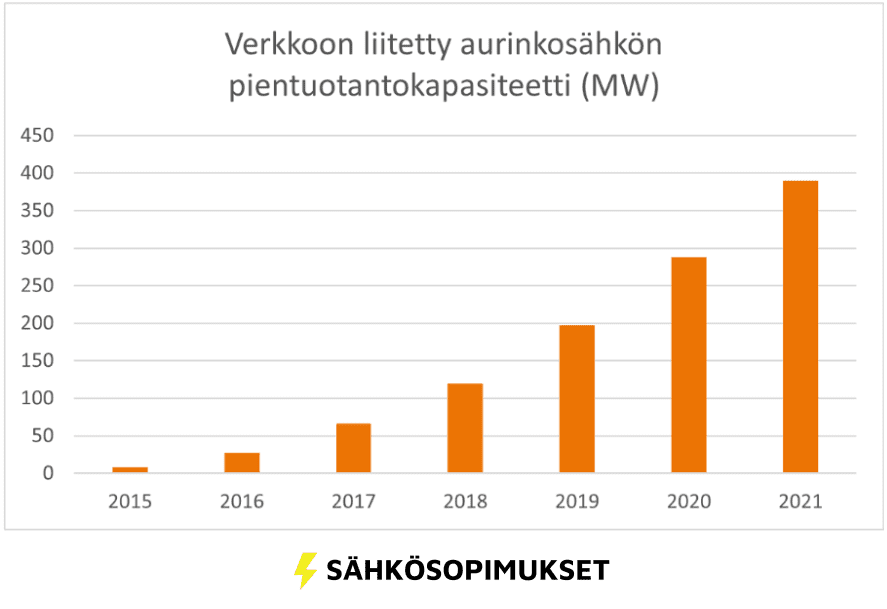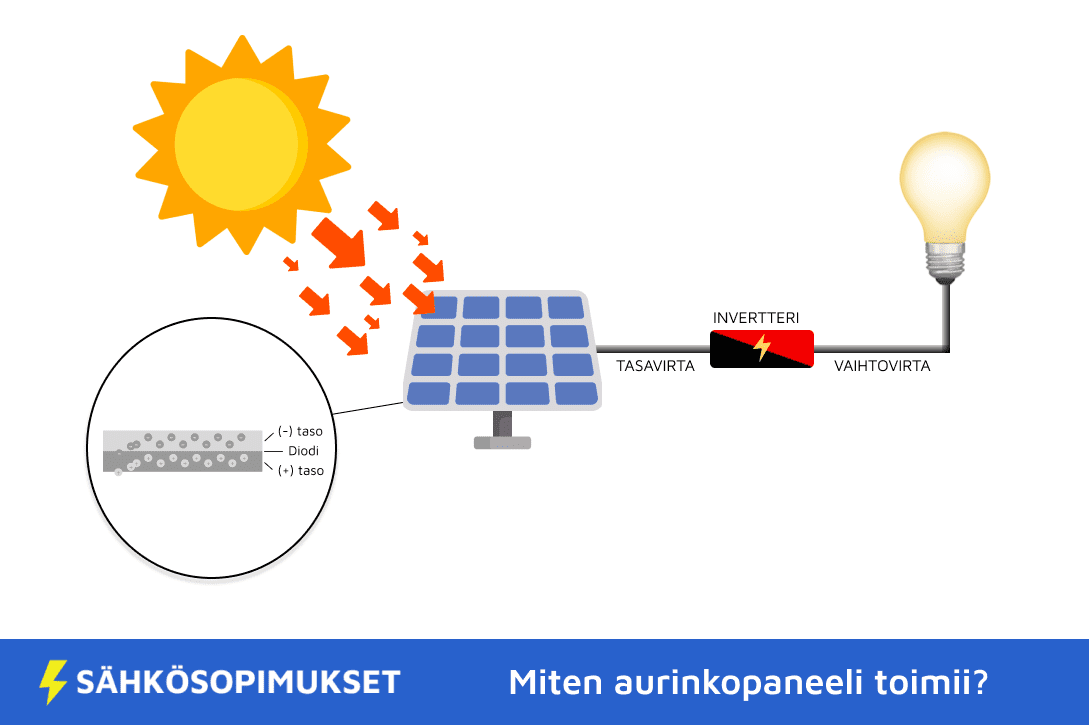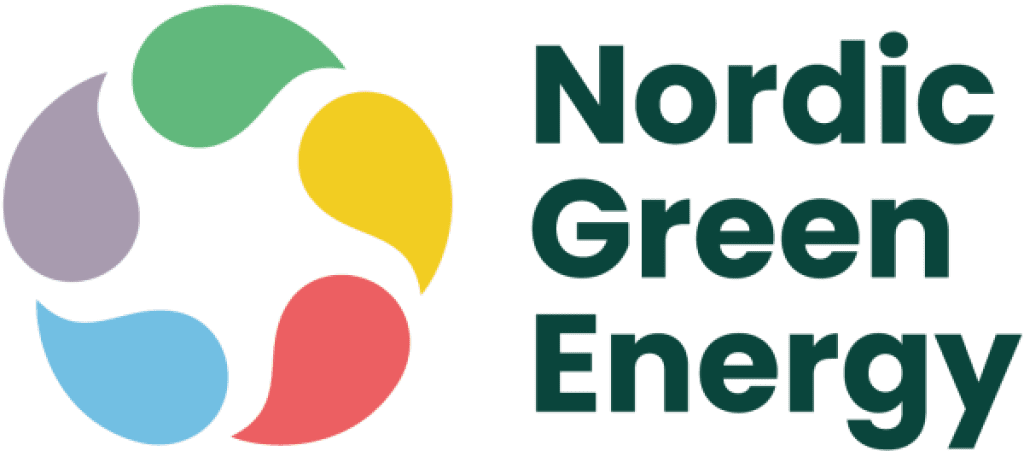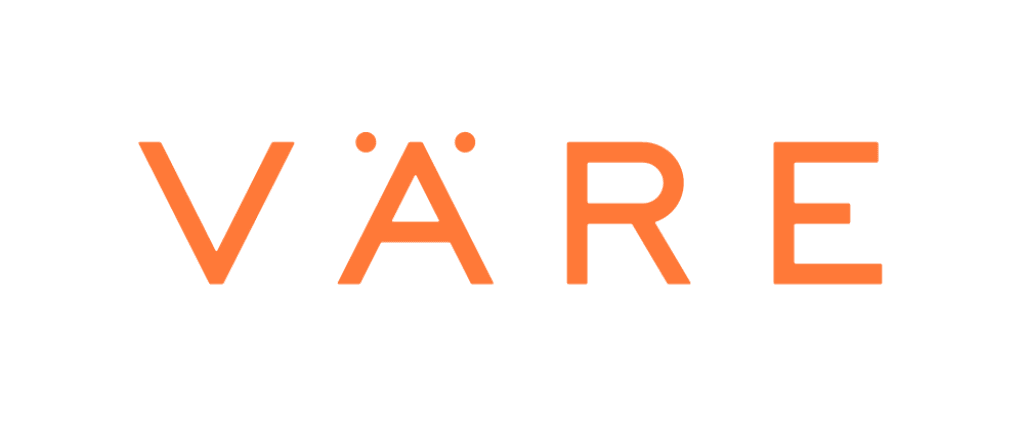Solar panels and solar energy in Finland
It is a renewable, clean and local form of energy that reduces dependence on the electricity grid and can bring savings in the long term.
Solar panels to your home
The average price for a high-quality solar electricity system is 7,000–10,000 euros and it is eligible for household deduction. If the system produces surplus electricity, you can sell it. The price is determined by Nord Pool - according to the electronic exchange.
Solar energy is one of the most environmentally friendly and efficient ways to generate energy. Although Finland may not be the first country that comes to mind when talking about solar energy, it is still a potential gambler in this growing energy market.
| Pros | Cons |
| 🌱 Reneweable energy | 💸 High set up costs |
| 💰 Low use costs | 🌦️ Dependent on the weather |
| 🌍 Reduces CO2 emissions | 🏡 Demands a lot of space |
| 😴 No noise pollution | ⚡️Production may be uneven |
In Finland, solar panels are becoming more common at a breakneck speed.
Several solar power parks are also under construction and planned in Finland, such as Finland's largest solar power park coming to Lapua, a truly modern mega project!

Where should you buy solar panels?
Some buy directly from the store, while others get the panels from their electricity company.
The potential of solar energy in Finland
Finland may not be the first country that comes to mind when talking about solar energy, but that doesn't mean that the country doesn't have potential in this form of energy.
Although Finland is known for its long, dark winters and short summers, the possibilities of solar energy are especially promising in the summer months. In summer, the days are long and the sun is in the sky for a long time, which makes it an ideal time for solar energy production.
In addition, the latest technologies make it possible to collect solar energy even in cloudy conditions and even in winter, when the sun is low. This considerably expands the possibilities of using solar energy in Finland.
Technological innovations
Finland is known for its high technological know-how, and this also applies to solar energy. Active research and development work is carried out in the country to utilize solar energy, and especially cold climate solar panel technology is one area where Finland is a global pioneer.
The use of monocrystalline silicon, efficient inverters and different coatings are technologies that improve the efficiency and durability of solar panels in cold and variable weather conditions.
Over the decades, Finland's strong engineering skills and culture of innovation have been strongly harnessed to achieve cleaner forms of energy.

How solar panels work
How solar panels work is a complex combination of physics and chemistry, but simply put, they convert sunlight into electrical energy.
The conversion takes place with the photoelectric effect, where the sun's light rays create an electric current by hitting the semiconductor and removing electrons from it. These electrons start moving and form an electric current.
Solar panels consist of several solar cells made of semiconductors such as silicon. Silicon has special properties that make it an excellent material for solar cells.
When the sun's rays hit these cells, electrons are set in motion and generate electricity. The electricity is initially direct current (DC), but it is converted to alternating current (AC) by an inverter so that it can be used in home appliances. 💡
As technology has developed, solar panels have become more and more efficient. The newest panels can work even in lower light conditions, which is particularly significant in the North.

Now you know how panels work. But are they worth buying?
Investing in solar panels in Finnish conditions - Does it make sense?
You can find many opinions about solar panels on the internet. Some of the opinions are political, some are marketing by the companies that produce them. In the midst of all this noise, the most important question for Finns is: Is it reasonable to buy solar panels in Finland?
Solar power is an increasingly important part of Finland's energy production, but there are some special features associated with its utilization. In Finland, a large part of the total radiation comes from diffuse radiation, which makes centralized and sun-tracking systems economically less sensible. On the other hand, traditional fixed solar panels are efficient, especially if they are installed correctly.
The amount of total radiation varies regionally in Finland, but is more or less at the same level as in Northern Germany. In southern Finland, the total radiation energy is about 980 kWh/m2 per year, while in northern Finland the figure is about 790 kWh/m2. The placement and tilt angle of the panels can significantly affect production: for example, panels placed at a 45 degree angle facing south can use up to 20-30% more radiation than horizontal panels.

Variations in the amount of radiation in different seasons and regions can be taken into account in energy calculations, and today various counters, such as the counter on Fingrid's website, offer the possibility of monitoring solar power forecasts and production statistics in real time.
In Finland, a lot of research has been done and data collected on the amount of solar radiation, and this information is freely available, for example, on the website of the Finnish Meteorological Institute. This provides valuable information to individuals as well as large energy companies planning solar power investments.
Initial investment
The purchase and installation of a solar panel system requires an initial investment, the size of which varies depending on the scope of the project. However, thanks to many subsidies and grants, this investment can be more accessible.
Subsidies and grants
In Finland, there are various subsidies and grants that facilitate the purchase of solar panels. These can be, for example, tax breaks or direct grants.
Generally available grants for solar panels:
| Subvention form | Target group | Description | Max amount and terms |
|---|---|---|---|
| Household deduction | Private persons | Intended to cover the installation costs of solar power systems. | The maximum amount is €2,250/person per year. Deductible €100. Reduction of 40% of the installation work costs when the work is carried out by the company. |
| Energy support from the Ministry of Employment and the Economy | Companies, municipalities and other non-community energy support | Intended for companies, municipalities and communities investing in solar electricity production. | Support is discretionary. The indicative subsidy percentage is 20% of the acceptable costs. |
Financing options
Jos alkukustannukset tuntuvat liian suurilta, on Suomessa tarjolla monenlaisia rahoitusvaihtoehtoja aurinkopaneelien hankintaan. Esimerkiksi osamaksulla tai lainalla voit jakaa investoinnin useammalle vuodelle. Monet pankit ja rahoituslaitokset tarjoavat erityisiä ”vihreitä lainoja” kestävään energiantuotantoon.
Some companies also offer leasing contracts along with installment payments, where the monthly payment covers the installation and maintenance of the panels. This can be a good option if you want to avoid investing a large initial capital.
Payback time
The payback period of solar panels depends on many factors. In general, the repayment period in Finland is 7–15 years. The size of the system and the electricity produced affect the time most significantly.
However, as technology develops in modern times, and energy prices rise, the payback period may shorten.
Installation and maintenance of solar panels
Installation
Installing solar panels is a precise job that starts with choosing the right installation location.
A pitched roof is usually the best option, but it is possible to install the panels on a flat roof and even at ground level using special stands. The orientation of the panels is usually south, but east and west installations are also effective.
Before installation, it is important to check that the roof structure is in good condition and that there is enough roof area to place the panels.
Installation work should always be left to a certified electrical contractor, as incorrect installation can affect warranty conditions and even home insurance coverage. With careful planning and professional installation, you get the best possible benefit from the solar panel system.
Quick guide to solar panel maintenance
Solar panels require little maintenance. Remember these points!
| 🧽 - Dirt and debris should be removed from the surface of the solar panels |
| ❄️ – Snow removal is usually not necessary and may even damage the panels |
| 🔋 – Inverters and batteries may require replacement during the lifetime of the panels |
| 🔌 - Electrical parts and fasteners should be visually inspected annually |
| 💦 - If the glass surface of the panels is damaged, it should be repaired waterproof |
| 👷 - All electrical work, such as replacing the inverter, should be left to professionals |
Solar panels for the cottage?
Solar panels are an excellent solution for cottage use, especially if the cottage is far from the electricity grid. From an environmental point of view, solar panels are also a valid choice, as they do not produce emissions and can help reduce the cabin's carbon footprint.
- The first thing to do is to estimate how much energy is actually needed at the cottage? This determines how many and what power solar panels you need.
- The location of the cabin is also an important factor: a south-facing roof usually gets more sunlight, but the newer panels work efficiently even in cloudier weather.
- Installation can be more challenging in remote areas, so it's a good idea to check if there are experienced installers nearby and how much the installation costs?
- The initial investment is often large for those with a normal income, but various subsidies and grants, such as the household deduction, can make the investment financially profitable in the long term.
- Remember that if the cabin is not used all year round, and the conditions are harsh, the solar panels may require special attention in winter storage!
The future of solar panels
Solar power has become one of the key factors in combating climate change and sustainable energy production. Although the advancement of technology creates great opportunities, its large-scale implementation also involves complex challenges.
Solar panels have become increasingly efficient and affordable in recent years. At the same time, energy storage technologies such as batteries and hydrogen have advanced, making solar power an increasingly attractive option.
In Finland, as elsewhere in the world, the placement of solar power plants is a complex issue. According to the government program, power plants should be located in wasteland and avoid forest areas. In practice, this can be challenging, as finding suitable areas is not always simple.
A recent Helsingin Sanomat article told the story of Maijaliisa Mattila, who had to move out of her home for a large-scale solar power plant project from the road in Ulvila. The story highlights an important aspect: when we talk about the future of solar power, we must also take into account its effects on local communities and individual people.
In the future, we can expect more and more detailed legislation and guidelines regarding the placement of solar power plants. This will probably control the size and location of the power plants as well as the technologies used.
The future of solar power is certainly bright, but its large-scale implementation requires many things to be taken into account.
For a sustainable future, it is essential that these challenges are recognized and solved responsibly.
Guidelines for purchasers and owners of solar panels
| 1. Purchase | 2. Installation | 3. Service and maintenance |
|---|---|---|
| Research and comparison: Find out about the different types of solar panels and their efficiency. Budgeting: Set a reasonable and cost-effective budget for the project. Offers: Request offers from several different suppliers. Selection: Choose a supplier and panel type that suits your needs and budget. Permits: Check if special permits are required for installation. | Professionals: Hire certified installers. Installation location: Choose the optimal location for the solar panel. Preparation: Make sure, that the ceiling or other installation location is ready for fixing the panels. Installation: Install the panels according to the instructions. Testing: Make sure the system works properly. | Cleaning: Regularly clean the panels of dirt and debris. Inspection: Perform regular inspections to ensure system performance. Monitoring: Use different applications or systems to monitor the performance of solar panels. Repairs: If there are any problems with the system, please have a professional fix them as soon as possible. Updates: Follow new technological innovations and update the system if necessary! |
FAQ
How much does a solar panel cost?
The price of one solar panel varies depending on the type, power and manufacturer. Prices can vary from around 100–300 euros per panel. However, this does not include other costs such as the inverter, installation or possible support structures.
How many solar panels for a detached house?
The solar panel requirement of a single-family house depends on the household's energy consumption. Generally, 3–10 kW systems are installed in detached houses. This means about 10 to 30 solar panels, depending on the power of the panels.
How long does the solar panel pay for itself?
The payback period for solar panels in Finland is usually 7–15 years, but this can vary based on the size of the system, yield and initial costs. As technology develops and energy prices rise, the payback period may shorten.
Can solar panels be tax deductible?
In Finland, it is possible to get a household deduction for the installation costs of a solar panel system. The reduction is 40% of the installation work costs and the maximum amount is €2,250/person per year. The deductible is €100.
Can I get an energy subsidy for solar panels?
In Finland, there are various subsidies and grants that facilitate the purchase of solar panels. Companies, municipalities and other communities can apply for energy support from the Ministry of Employment and the Economy for solar electricity production. The support is discretionary and the indicative support percentage is around 20% of the acceptable costs.
How much does a 6 kW solar panel yield?
The output of a 6 kW solar panel system depends on many factors such as location, angle of installation of the panels and weather conditions. In Finland, the average annual yield could be around 4,000 – 6,000 kWh. In the summer months, the yield is usually higher.







